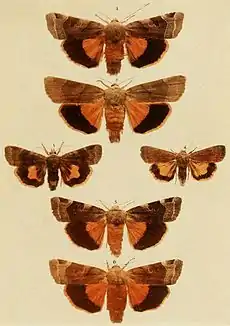Noctua interjecta
Noctua interjecta, the least yellow underwing, is a species of moth of the family Noctuoidea. It is found in Europe.
| Least yellow underwing | |
|---|---|
 | |
| Scientific classification | |
| Kingdom: | Animalia |
| Phylum: | Arthropoda |
| Class: | Insecta |
| Order: | Lepidoptera |
| Superfamily: | Noctuoidea |
| Family: | Noctuidae |
| Genus: | Noctua |
| Species: | N. interjecta |
| Binomial name | |
| Noctua interjecta Hübner, 1803 | |

Subspecies
There are two subspecies:
- Noctua interjecta interjecta (Alps, southern France, northern and south-eastern Spain, northern Portugal, Italy, Bulgaria, northern Greece and Romania)
- Noctua interjecta caliginosa (Schawerda, 1919) (southern and central England, Wales, southern Ireland, northern France, Belgium, Luxemburg, Netherlands, northern Germany, Denmark, southern Sweden, Czech Republic and Austria)
Description
The wingspan is 31–36 mm. The length of the forewings is 14–17 mm. Forewing greyish rufous, sometimes darkened with fuscous; lines and stigmata a little darker, often very obscure; hindwing orange yellow with a broad marginal black border; costal and inner margins, a submedian streak from base, and the cell blackish; fringe yellow.[1]
The larva is pale ochreous with black dots; the lines pale, with darker edges.
Biology

In Belgium and the Netherlands, this species flies in one generation from late June to August.
The larvae feed on various grasses and herbaceous plants such as meadowsweet (Filipendula ulmaria) and common mallow (Malva sylvestris).[2]
References
- Seitz, A. Ed., 1914 Die Großschmetterlinge der Erde, Verlag Alfred Kernen, Stuttgart Band 3: Abt. 1, Die Großschmetterlinge des palaearktischen Faunengebietes, Die palaearktischen eulenartigen Nachtfalter, 1914
- "Robinson, G.S., P.R. Ackery, I.J. Kitching, G.W. Beccaloni, & L.M. Hernández. (2010). HOSTS – A Database of the World's Lepidopteran Hostplants. Natural History Museum, London".
External links
| Wikimedia Commons has media related to Noctua interjecta. |
- Lepiforum
- Noctua interjecta, at Markku Savela's Lepidoptera and Some Other Life Forms
- Fauna Europaea
- Noctua interjecta (Hübner, 1803), Lepidoptera of Belgium
- Least yellow underwing, at UKMoths